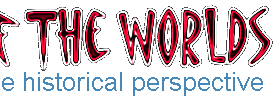Independence Day (1996)

Independence Day (abbreviated sometimes to ID4) is the movie that dare not speak
its name, in this case that name being War of the Worlds. To say that this movie owes
a debt to The War of the Worlds is the understatement of the century, with parallels
galore. Of course H.G. Wells was the first to popularise the entire idea of aliens
invading the Earth and so just about every alien invasion movie ever made owes him
that same debt, but Independence Day is really quite breathtakingly blatant in its
expropriation of the core concepts of The War of the Worlds.
A few days before the July 4th Independence Day, a massive spacecraft is detected entering
Earth orbit. The world holds its collective breath, as in a majestic display of raw
power, the Mothership disgorges a fleet of spacecraft, which assume intimidating position
over every major city on Earth. No communication is forthcoming, and the world wonders
just what these alien visitors intend. In the New York office of a television broadcaster,
technical whiz David Levinson (Jeff Goldblum) has a nasty suspicion that he knows exactly
what they are planning. He has figured out what has been disrupting worldwide communications
since the alien arrival. Hidden in normal signals from our own communication satellites is
a foreign transmission, and it is counting down. (Incidently, Goldblum also has another War of the Worlds
related movie on his CV, the very different and completely insane Buckaroo Banzai.)
Meanwhile Captain Steven Hiller (Will Smith) of the US Airforce finds his leave rudely
disrupted by the arrival of the aliens and in the Whitehouse the President (Bill Pullman)
wonders with his advisors just what to do about this momentous event. Racing to Washington
with his father, David knows the clock is ticking, and the only hope is to get an audience
with the President via is estranged wife, who happens to be one of his top advisors. With
minutes to spare, David gets into the Whitehouse and explains his theory. Luckily he is a
persuasive sort of person, and the President orders an immediate evacuation. As Air force
One clears the runway, the countdown hits zero and all of the alien spacecraft (one of
which is positioned directly over the Whitehouse) let rip with enormous energy blasts.
City after city, including Washington and New York, are obliterated.
Independence Day is a clever film, giving audiences exactly what they like; wholesale
destruction and a likable band of disparate characters who we know will come together at
the finale to set things right. Along the way we get plenty of thrills and human pathos,
but as I mentioned at the beginning of this review, Independence Day borrows liberally
from The War of the Worlds, not just the book in fact, but other subsequent versions.
Like the book, we have an implacable alien foe and a seemingly futile human resistance,
and just as in the book, the humans rally to counter attack and are soundly routed,
though in Wells' book it is British artillery that is devastated by the Heat Ray, in
Independence Day it is American fighter planes against alien warships. In 1953, George
Pal re-located the story of The War of the Worlds from Victorian England to cold war
America and took the quite obvious decision to invoke the nuclear demon as the ultimate
expression of American military might. It fails, as does the same tactic in Independence
Day when it is found that the aliens are protected by an invulnerable force shield, a
direct borrowing from Pal, even down to the observers waiting for the nuclear cloud to
dissipate and reacting in despair as the aliens emerge without a scratch.
Another unacknowledged borrowing is the use of news reports throughout the film to give
a sense of realism to events, but this comes not from the Pal film, but the Orson Welles
radio broadcast of 1938. The Welles broadcast spooked listeners by fooling them into
thinking they were listening to a live news report of a Martian invasion, and Independence
Day writers Dean Devlin & Roland Emmerich cleverly expand on this by drafting in real
newscasters to play themselves in the news reports.
Most tellingly, (and Devlin & Emmerich have admitted as much in the DVD commentary) the
method by which the humans finally defeat the aliens is a pure nod to Wells, though one
that has infuriated a good many people. It is the character of David (Goldblum) who comes
up with the solution to the problem of the alien energy shields. Holed up in Area 51 (the
holy grail of UFO conspiracy theorists) he is confronted with the evidence that the
American government has known about aliens for a long time. Beneath the base in a high
security underground facility is an alien fighter craft recovered at Roswell in 1947.
Examining the spacecraft, David realises that the only way to penetrate the energy shields
is to give the aliens "a cold." It was of course common Earthly germs that defeated the
Martians in The War of the Worlds, but this being a gung ho American movie, it is deemed
unacceptable to allow Mother Nature to come to the rescue. In Independence Day, it has to
be the plucky (American) humans who save the day. To this end David writes a computer virus,
which he will need to deliver to the alien Mothership.
With Stephen (Will Smith) as his pilot, the two intrepidly de-mothball the captured alien
fighter and fly it to the Mothership, and in one of the most outrageously contrived ideas
in movie history, proceed to upload the virus from David's Apple laptop to the alien
computer network, surely a fantastic advert for Apple, but massively implausible given
the difficulties you normally face in interfacing two different human operating systems,
let alone one designed by alien minds. Suffice to say, it works, and the humans launch a
final last-ditch attack against the aliens, which succeeds in penetrating the shields.
So Independence Day is a completely ludicrous film, but you can't help but like its
exuberance and total disregard for logic. The effects are breathtaking and groundbreaking,
and the performances engaging, though viewers outside of American will probably have to grit
their teeth through some of the more patriotic moments, especially Pullman's toe-curlingly
"inspiring" speech prior to the final assault on the aliens. At heart, this is very much an
American movie for American audiences, offering them that curiously therapeutic experience
of watching their landmarks get blasted apart, their government revealed as duplicitous, and
yet emerging at the end from their trial by fire renewed and re-assured at the fundamental
righteousness of their society.
|
Buy
See also in:
Film & TV
|
1953
The War of the Worlds by George Pal. The action relocates to cold war America, with the Martian war machines re-invented as sinister flying machines.
|
|
1968
Robinson Crusoe on Mars. The Martian war machines from the George Pal movie are the foe for an astronaut stranded on Mars.
|
|
1984
Buckaroo Banzai. One of the wildest and weirdest films to feature a War of the Worlds reference, Buckaroo Banzai is pretty much indefinable.
|
|
1988
War of the Worlds An intermittently impressive TV series about a second Martian invasion of Earth.
|
|
2005
The War of the Worlds Steven Spielberg and Tom Cruise get a huge bang for their bucks in this massive re-imagining of The War of the Worlds.
|
|





